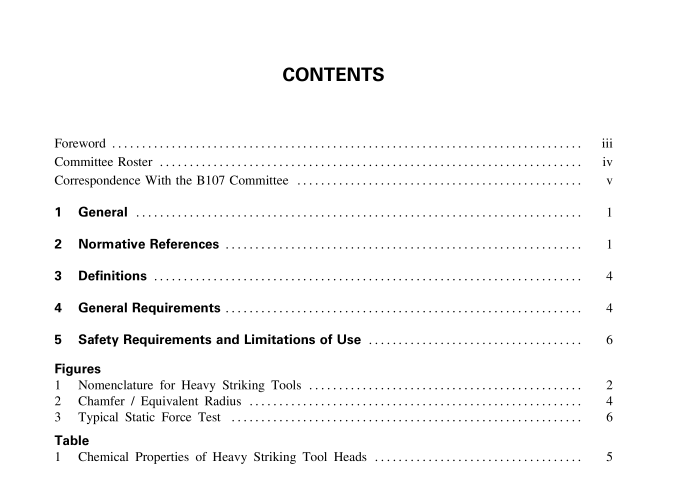ASME B107.54:2001 pdf free download HEAVY STRIKING TOOLS: SAFETY REQUIREMENTS
1 GENERAL1.1 Scope
This Standard provides safety requirements for thedesign,construction,testing, and use of the followingstyles of heavy striking tools. The names given andintended uses are those generally recognized (see Fig. 1).(a) Blacksmith’s Double-Face Sledges. Nevada long-pattern striking hammers,and Oregon short-patternstriking hammers,intended specifically for use in generalsledging operations in striking wood,metal,masonry,and stone.
(b) Hand Drilling Hanners. Intended specificallyfor use in striking chisels,punches,star drills, spikes,and hardened nails.
(c) Blacksmith ‘s Cross-Peen Sledges. The strikingface of which is intended specifically for use in generalsledging operations in striking wood,metal,masonry,and stone and the peen face of which is intendedspecifically for use in bending and fullering (necking) unhardened metal.
(d) Woodchopper’s Maul. The bit end of which isintended specifically for splitting logs and the striking face of which is intended specifically for driving metalwood-splitting wedges into logs.
(e) Railroad Spike Maul. Intended specifically foruse in driving railroad spikes.
(f)Spalling Hammers. Intended specifically for use
in cutting and shaping stone and masonry by firstmaking a score line with the peen and then tapping away
the unwanted stone or masonry with the striking face.(g)Stone Sledge. The peen end of which is intendedspecifically for making score lines in stone and masonryand the striking face of which is intended specificallyfor use in breaking up stone and masonry.
h) Bush Hanmers. Intended specifically for use inroughing and chipping concrete.
(i)Boat Mauls. Intended specifically for use indriving wooden wedges and wooden pegs.
(j) Lineman’s or Farrier’s Turning Hamners. In-tended specifically for use by telephone and electricutility linemen or by farriers (blacksmiths) in formingand shaping horseshoes.
1.2 Purpose
This Standard is intended to serve as a guide inselecting,testing,and using the hand tools covered.Details of design,testing,and use of the tools coveredare specified only as they relate to safety.It is not thepurpose of this Standard to specify the details ofmanufacturing.
This Standard is also meant to serve as a guide indeveloping manuals and posters and for training person-nel to work safely.
1.3 Application
This Standard may be used as a guide by stateauthorities or other regulatory bodies in the formulationof laws or regulations. It is also intended for voluntaryuse by establishments that use or manufacture the toolscovered.
The methods employed to ensure compliance with thisStandard shall be determined by the proper regulatory oradministrative authority.
1.4 Shall and Should
Mandatory requirements of this Standard are charac-terized by the word shall. If a provision is of anadvisory nature,it is indicated by the word should oris stated as a recommendation.
1.5 Equivalent
The word equivalent in this Standard shall be interpre-ted to mean alternative designs or features that willprovide an equal degree of safety.
2 NORMATIVE REFERENCES
The following documents form a part of this Standardto the extent specified herein. At the time of publication,the editions indicated were valid. All standards aresubject to revision,and parties to agreements based onthis Standard are encouraged to investigate the possibil-ity of applying the most recent editions of the standardsindicated below.
3DEFINITIONs (See Figs. 1 and 2, asapplicable)
For the purpose of this Standard,the followingdefinitions apply:
blade: the broad tapering portion of the maul betweenthe eye and the cutting edge of the woodchopper’s maul.chamfer: the bevel or equivalent radius encircling theperimeter of the striking face. Also,the bevel on theends of fullering surfaces and scoring edges (see Fig. 2).cutting edge:the sharpened end of the blade of thewoodchopper’s maul.
eye:an opening or aperture in the head into whichthe handle is inserted if the handle is separate.
fullering surface: the rounded surface directly oppositethe striking face of the blacksmith’s cross-peen sledge.handle:the portion that protrudes from the head andby which the tool is held.
handle grip:additional material securely attached tothe handle to be gripped during use.
peen:the tapered portion of the hammer or sledgebetween the eye and the scoring edge or fulleringsurface.
poll: the portion of the hammer,sledge,maul,orbush hammer between the eye and the chamfer orstriking face.
safety message:the information imprinted on or af-fixed to the hammer that is intended to promote safety.
ASME B107.54:2001 pdf free download
